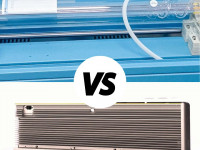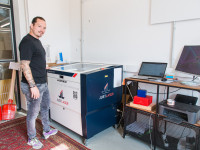Temper marking with a laser
The revolution in component marking and industrial labeling
Component marking and industrial labeling play a critical role in today's manufacturing industry. Until now, conventional methods such as engraving, etching or pad printing have been used to mark components. But thanks to the revolutionary technology of the laser, a whole new era in annealing marking is opening up.
In the modern manufacturing industry, component marking plays a crucial role. It is used not only for identification, but also for quality assurance and compliance with standards. Here, annealing marking with a laser has established itself as an extremely efficient method for component marking and part identification.
The conventional methods of labeling
Traditional methods of marking have worked well for a long time, but are now obsolete. Initially, there was the method of mechanical engraving, which used a spindle and a template to engrave letters or symbols on the component. However, this was time-consuming and not very precise.
Then came electrolytic marking, in which a strong current was passed through the component to create an oxide layer and thus permanently mark letters or symbols. However, this method was not only expensive, but also environmentally harmful.
With the laser as a revolutionary technology, this has now changed. The laser can work quickly and precisely as well as process various materials - from plastic to metal to glass - without damaging the material itself. This makes it possible to achieve high-quality results with a high level of repeatability.
What is temper marking?
When creating annealing marks, laser technology raises the temperature of the metal locally to just before the melting point. This process causes a change in the crystal lattice and leads to the formation of oxide layers on the surface of the workpiece. The result is visible annealing colors that remain stable up to a temperature of around 200°C. If the temperature exceeds this value, the crystal lattice returns to its original state and the marking disappears. The surface structure remains unchanged.
Temper marks are generally only suitable for metals that undergo color changes due to the effects of heat and oxygen. These include special types of steel and titanium. This technique cannot be used for materials such as aluminum or non-ferrous metals. Likewise, carbide cannot be marked in a dark contrast by temper marking.
Temper marking is a special process that uses the application of laser beams to permanently immortalize information on a surface. Unlike other processes such as printing or engraving, annealing changes the properties of the material itself. This makes the marking not only permanent, but also resistant to abrasion, heat and chemicals.
Advantages of temper marking in industrial marking
The advantages of annealing with a laser are manifold:
- Maximum precision: The technology enables extremely fine lines and contours, which is particularly important in industrial marking.
- Speed: Automating the process makes part marking much faster than traditional methods.
- Flexibility: Whether text, numbers or even barcodes, laser marking makes part marking versatile and easy to customize.
Application areas
Component labeling and industrial marking is an important part of the production process for many companies. Clear marking of components enables fast identification, efficient warehousing and smooth logistics. Until now, conventional methods such as electrical temper marking or engraving have been used.
But with the use of lasers as a marking technology, a revolution has occurred in the industry. The advantages are obvious: a laser can work precisely and quickly, resulting in increased efficiency and cost savings. The quality of the results is also higher with the use of a laser, as there is no material degradation with this process. In addition, industries such as the automotive industry, medical technology or electrical engineering benefit from the use of this technology.
Increased efficiency and cost savings through the use of a laser
Using a laser for marking brings huge efficiency gains and cost savings. Compared to conventional methods such as stamping or engraving, annealing marking with a laser can be performed faster, more precisely and more accurately. This eliminates long waiting times and machine downtime, resulting in higher productivity. The cost of materials such as stamps or engraving tools is also completely eliminated because the laser applies directly to the component. In addition, the process is very flexible to use and enables individual marking without additional costs for new tools or changes to existing manufacturing processes. The result is more precise and durable than anything else on the market.
All of these benefits make the use of lasers in marking a worthwhile investment for companies of all industries and sizes.



